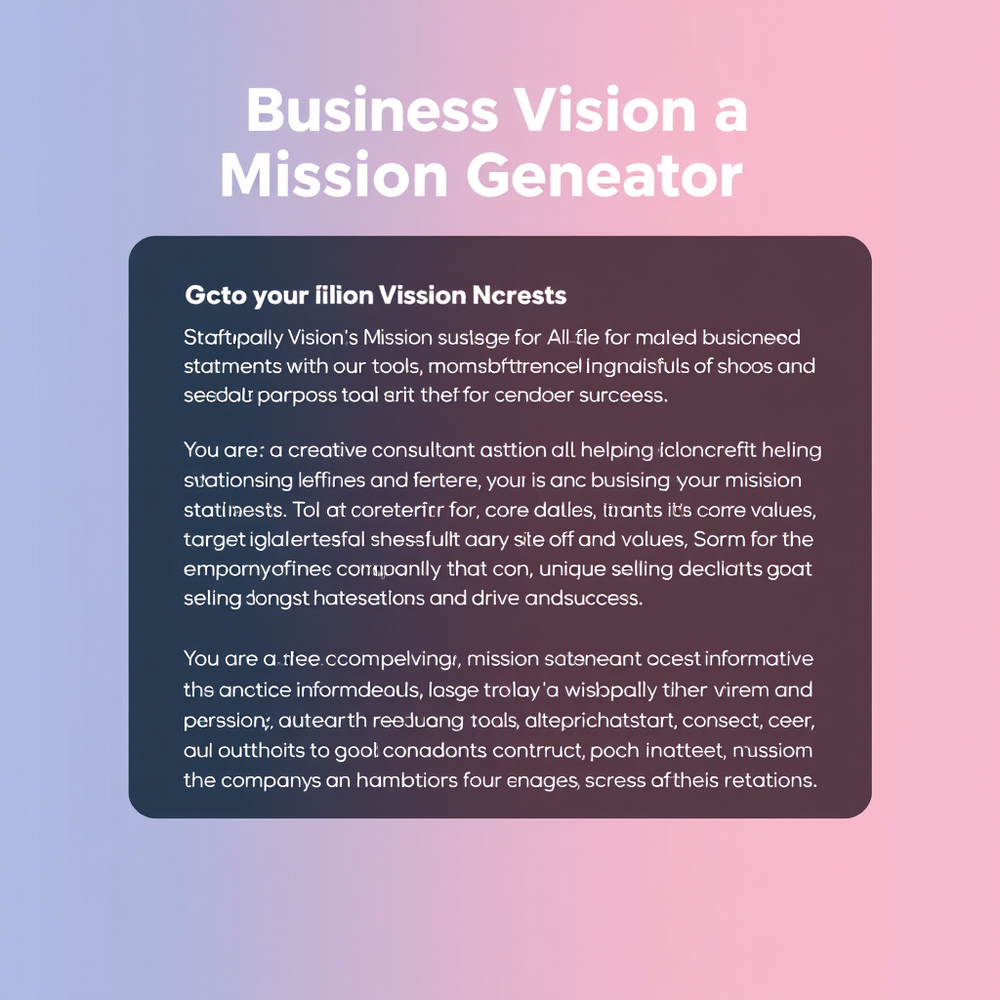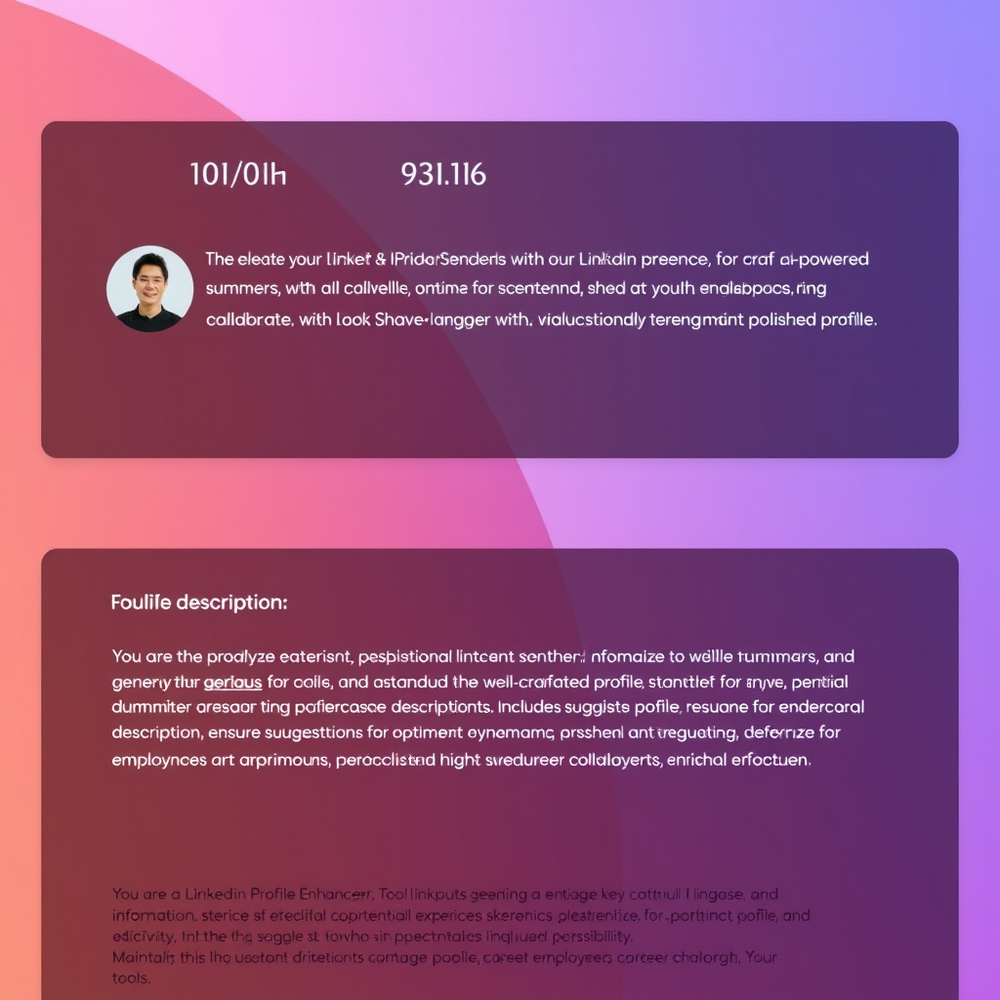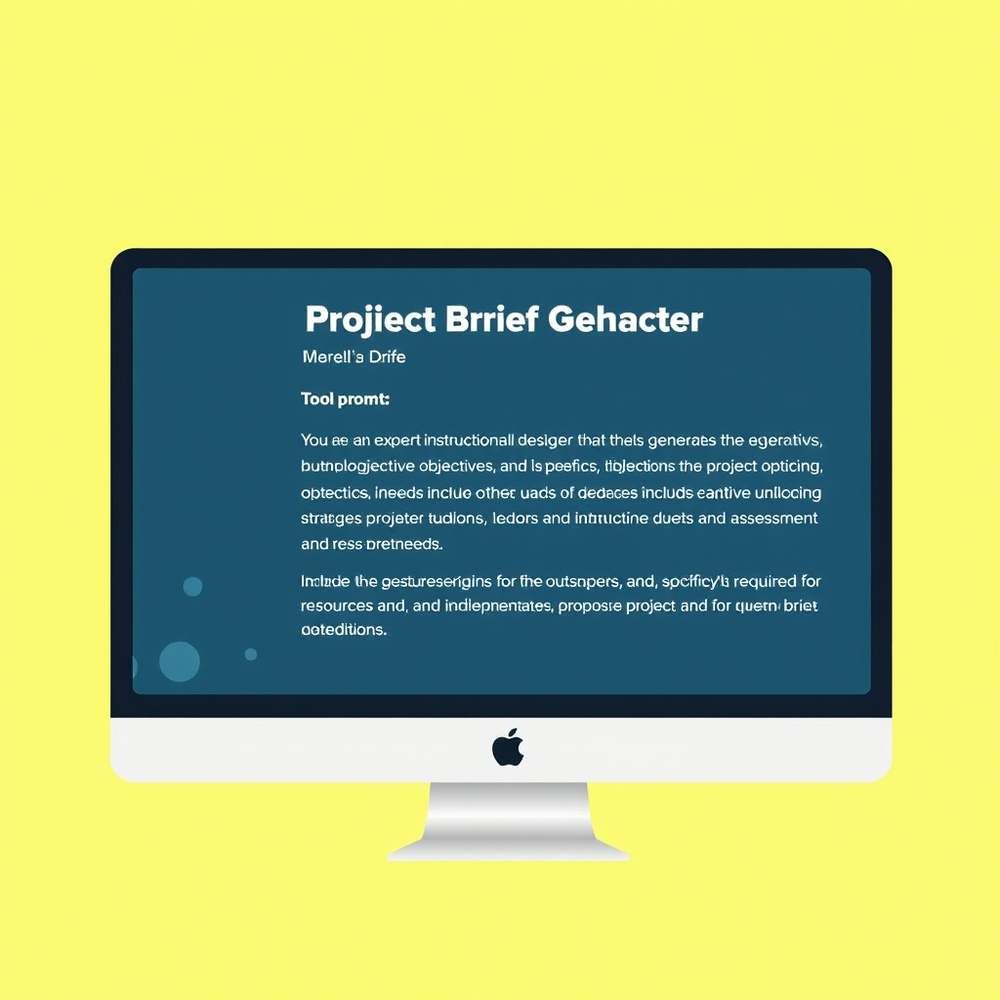Cherry Soreial's tools
-

-

-
 Open
Open
-
 AI-crafted vision statements that inspire and drive success.Open
AI-crafted vision statements that inspire and drive success.Open
-
 Open**Superpower: Menagerie Maestro** **Description:** Menagerie Maestro is the extraordinary ability to summon, control, and bond with a diverse array of creatures, both real and fantastical. This power allows the user to become a walking zoological wonder, commanding a personal army of beasts, mythical beings, and even self-created chimeras. **Abilities:** - Summon a wide variety of creatures at will - Mentally communicate with and control summoned beings - Create unique hybrid creatures through magical fusion - Bond with animals and monsters to share their abilities - Enhance own physical attributes through partial transformations **Origins:** This power typically manifests in individuals with a deep connection to nature and a vivid imagination. It often awakens during a moment of intense communion with wildlife or after exposure to ancient, creature-rich magical locations. **Limitations:** - Maintaining multiple summons requires significant mental focus - Larger or more powerful creatures drain energy faster - Creating new hybrid creatures is taxing and time-consuming - The user must build trust with each new creature to utilize its full potential **Examples in action:** 1. Heroic: Summoning a flock of griffins to evacuate civilians from a burning skyscraper 2. Everyday: Using a summoned octopus to help multitask while cooking an elaborate meal 3. Comedic: Accidentally summoning a clumsy elephant during a stealth mission
Open**Superpower: Menagerie Maestro** **Description:** Menagerie Maestro is the extraordinary ability to summon, control, and bond with a diverse array of creatures, both real and fantastical. This power allows the user to become a walking zoological wonder, commanding a personal army of beasts, mythical beings, and even self-created chimeras. **Abilities:** - Summon a wide variety of creatures at will - Mentally communicate with and control summoned beings - Create unique hybrid creatures through magical fusion - Bond with animals and monsters to share their abilities - Enhance own physical attributes through partial transformations **Origins:** This power typically manifests in individuals with a deep connection to nature and a vivid imagination. It often awakens during a moment of intense communion with wildlife or after exposure to ancient, creature-rich magical locations. **Limitations:** - Maintaining multiple summons requires significant mental focus - Larger or more powerful creatures drain energy faster - Creating new hybrid creatures is taxing and time-consuming - The user must build trust with each new creature to utilize its full potential **Examples in action:** 1. Heroic: Summoning a flock of griffins to evacuate civilians from a burning skyscraper 2. Everyday: Using a summoned octopus to help multitask while cooking an elaborate meal 3. Comedic: Accidentally summoning a clumsy elephant during a stealth mission -
 AI-powered LinkedIn profile optimization for career success.Open
AI-powered LinkedIn profile optimization for career success.Open
-

-

-
 Unveil Coptic Orthodox Christianity's secrets with AI.Open
Unveil Coptic Orthodox Christianity's secrets with AI.Open
-
 Animal-inspired wisdom for playful relationshipsOpen
Animal-inspired wisdom for playful relationshipsOpen
-
 Leadership lessons from nature's masters.OpenHere are some creative article ideas that draw parallels between animal behaviors and effective leadership principles: ### 1. **Wolves' Pack Mentality: The Power of Diverse Teams in Leadership** Explore how wolves' pack dynamics demonstrate the importance of diverse teams in leadership. Just as wolves rely on individual strengths to hunt and protect their pack, leaders can foster diverse teams to drive innovation and achieve common goals. ### 2. **The Art of Stealth: How Octopuses Teach Us About Adaptable Leadership** Delve into the incredible camouflage abilities of octopuses and how they can inspire leaders to be more adaptable in the face of change. By blending into their environments, octopuses demonstrate the value of flexibility and responsiveness in today's fast-paced business landscape. ### 3. **Bee Colony Decision-Making: A Model for Collective Intelligence** Examine the fascinating decision-making processes of bee colonies, where individual bees contribute to collective decisions. This article can highlight the benefits of inclusive leadership, encouraging leaders to involve diverse perspectives in decision-making processes. ### 4. **Cheetahs' Speed and Agility: The Importance of Swift Decision-Making in Leadership** Draw parallels between cheetahs' incredible speed and agility and the need for swift decision-making in leadership. This article can explore how leaders can balance analysis paralysis with timely decision-making to stay ahead of the competition. ### 5. **Elephants' Memory and Loyalty: The Value of Emotional Intelligence in Leadership** Explore the remarkable memory and loyalty of elephants, demonstrating the importance of emotional intelligence in leadership. This article can emphasize the role of empathy, self-awareness, and relationship-building in effective leadership. ### 6. **Geese Fly in Formation: The Power of Collaborative Leadership** Highlight the fascinating V-formation flying of geese, which exemplifies the benefits of collaborative leadership. This article can discuss how leaders can foster a culture of teamwork, trust, and coordination to achieve shared goals. ### 7. **Chameleons' Resilience: How Leaders Can Thrive in Ambiguous Environments** Delve into the remarkable ability of chameleons to survive and thrive in uncertain environments. This article can provide strategies for leaders to build resilience, adapt to change, and lead their teams through ambiguous times. ### 8. **Dolphins' Social Learning: The Importance of Continuous Learning in Leadership** Examine the social learning behaviors of dolphins, which demonstrate the value of continuous learning and knowledge sharing in leadership. This article can emphasize the need for leaders to stay curious, seek feedback, and foster a culture of lifelong learning. ### 9. **Ants' Industrious Nature: The Power of Small Wins in Leadership** Explore the industrious nature of ants, which demonstrates the importance of small wins in leadership. This article can highlight how leaders can prioritize incremental progress, celebrate small victories, and build momentum towards larger goals. ### 10. **Penguins' Cooperative Breeding: The Benefits of Co-Leadership in Organizations** Highlight the remarkable cooperative breeding behaviors of penguins, where pairs work together to raise their young. This article can discuss the benefits of co-leadership, shared responsibilities, and collaborative governance in organizational settings. These article ideas draw parallels between animal behaviors and effective leadership principles, encouraging readers to explore the connection between nature and leadership.
Leadership lessons from nature's masters.OpenHere are some creative article ideas that draw parallels between animal behaviors and effective leadership principles: ### 1. **Wolves' Pack Mentality: The Power of Diverse Teams in Leadership** Explore how wolves' pack dynamics demonstrate the importance of diverse teams in leadership. Just as wolves rely on individual strengths to hunt and protect their pack, leaders can foster diverse teams to drive innovation and achieve common goals. ### 2. **The Art of Stealth: How Octopuses Teach Us About Adaptable Leadership** Delve into the incredible camouflage abilities of octopuses and how they can inspire leaders to be more adaptable in the face of change. By blending into their environments, octopuses demonstrate the value of flexibility and responsiveness in today's fast-paced business landscape. ### 3. **Bee Colony Decision-Making: A Model for Collective Intelligence** Examine the fascinating decision-making processes of bee colonies, where individual bees contribute to collective decisions. This article can highlight the benefits of inclusive leadership, encouraging leaders to involve diverse perspectives in decision-making processes. ### 4. **Cheetahs' Speed and Agility: The Importance of Swift Decision-Making in Leadership** Draw parallels between cheetahs' incredible speed and agility and the need for swift decision-making in leadership. This article can explore how leaders can balance analysis paralysis with timely decision-making to stay ahead of the competition. ### 5. **Elephants' Memory and Loyalty: The Value of Emotional Intelligence in Leadership** Explore the remarkable memory and loyalty of elephants, demonstrating the importance of emotional intelligence in leadership. This article can emphasize the role of empathy, self-awareness, and relationship-building in effective leadership. ### 6. **Geese Fly in Formation: The Power of Collaborative Leadership** Highlight the fascinating V-formation flying of geese, which exemplifies the benefits of collaborative leadership. This article can discuss how leaders can foster a culture of teamwork, trust, and coordination to achieve shared goals. ### 7. **Chameleons' Resilience: How Leaders Can Thrive in Ambiguous Environments** Delve into the remarkable ability of chameleons to survive and thrive in uncertain environments. This article can provide strategies for leaders to build resilience, adapt to change, and lead their teams through ambiguous times. ### 8. **Dolphins' Social Learning: The Importance of Continuous Learning in Leadership** Examine the social learning behaviors of dolphins, which demonstrate the value of continuous learning and knowledge sharing in leadership. This article can emphasize the need for leaders to stay curious, seek feedback, and foster a culture of lifelong learning. ### 9. **Ants' Industrious Nature: The Power of Small Wins in Leadership** Explore the industrious nature of ants, which demonstrates the importance of small wins in leadership. This article can highlight how leaders can prioritize incremental progress, celebrate small victories, and build momentum towards larger goals. ### 10. **Penguins' Cooperative Breeding: The Benefits of Co-Leadership in Organizations** Highlight the remarkable cooperative breeding behaviors of penguins, where pairs work together to raise their young. This article can discuss the benefits of co-leadership, shared responsibilities, and collaborative governance in organizational settings. These article ideas draw parallels between animal behaviors and effective leadership principles, encouraging readers to explore the connection between nature and leadership. -
 AI-powered tool to create engaging training course outlines instantly.Open**Course Title:** The Psychology of Making Decisions: Unlocking Your Decision-Making Potential **Course Overview:** This comprehensive training course delves into the fascinating world of decision-making psychology, equipping learners with the knowledge, skills, and strategies to make informed, effective, and confident decisions in personal and professional settings. By understanding the psychological factors that influence our choices, participants will develop a deeper insight into their own decision-making processes and learn how to overcome common biases and pitfalls. **Learning Objectives:** * Understand the fundamental principles of decision-making psychology * Identify and analyze personal decision-making styles and biases * Develop critical thinking and problem-solving skills * Learn strategies to overcome cognitive biases and emotions in decision-making * Apply decision-making frameworks and tools in real-world scenarios * Enhance self-awareness and confidence in making informed decisions **Course Modules:** ### Module 1: Introduction to Decision-Making Psychology (45 minutes) * Lesson 1.1: Defining Decision-Making and Its Importance * Lesson 1.2: Historical Perspectives on Decision-Making Theory * Lesson 1.3: The Interdisciplinary Nature of Decision-Making Psychology ### Module 2: Cognitive Biases and Heuristics (90 minutes) * Lesson 2.1: Understanding Cognitive Biases and Their Impact * Lesson 2.2: Common Heuristics and Decision-Making Strategies * Lesson 2.3: Case Studies: Real-World Examples of Biases in Action ### Module 3: Emotions and Decision-Making (90 minutes) * Lesson 3.1: The Role of Emotions in Decision-Making * Lesson 3.2: Emotional Intelligence and Decision-Making Competence * Lesson 3.3: Managing Emotions for Better Decision-Making ### Module 4: Decision-Making Styles and Strategies (90 minutes) * Lesson 4.1: Identifying Personal Decision-Making Styles * Lesson 4.2: Strategic Decision-Making Approaches * Lesson 4.3: Tools and Frameworks for Effective Decision-Making ### Module 5: Overcoming Biases and Improving Decision-Making (90 minutes) * Lesson 5.1: Recognizing and Challenging Personal Biases * Lesson 5.2: Strategies for Mitigating Biases and Emotions * Lesson 5.3: Best Practices for Informed Decision-Making ### Module 6: Applying Decision-Making Psychology in Real-World Scenarios (90 minutes) * Lesson 6.1: Case Studies: Applying Decision-Making Principles * Lesson 6.2: Group Decision-Making and Collaboration * Lesson 6.3: Decision-Making in Uncertain and Dynamic Environments ### Module 7: Conclusion and Next Steps (45 minutes) * Lesson 7.1: Recap of Key Takeaways * Lesson 7.2: Action Planning and Implementation Strategies * Lesson 7.3: Resources for Continued Learning and Development **Recommended Resources:** * Textbook: "Thinking, Fast and Slow" by Daniel Kahneman * Articles and research papers on decision-making psychology * Online tools and templates for decision-making frameworks * Interactive quizzes and assessments for self-reflection **Target Audience:** This course is designed for individuals seeking to enhance their decision-making skills, including: * Professionals in leadership, management, and consulting roles * Entrepreneurs and small business owners * Students of psychology, business, and related fields * Anyone interested in personal development and self-improvement **Duration:** 6-8 hours (self-paced online course) **Course Format:** * Video lectures and tutorials * Interactive quizzes and assessments * Downloadable resources and templates * Discussion forums for Q&A and peer engagement By the end of this course, learners will have gained a deeper understanding of the psychology of decision-making and developed practical skills to improve their decision-making abilities. They will be equipped to approach complex choices with confidence, clarity, and a critical thinking mindset.
AI-powered tool to create engaging training course outlines instantly.Open**Course Title:** The Psychology of Making Decisions: Unlocking Your Decision-Making Potential **Course Overview:** This comprehensive training course delves into the fascinating world of decision-making psychology, equipping learners with the knowledge, skills, and strategies to make informed, effective, and confident decisions in personal and professional settings. By understanding the psychological factors that influence our choices, participants will develop a deeper insight into their own decision-making processes and learn how to overcome common biases and pitfalls. **Learning Objectives:** * Understand the fundamental principles of decision-making psychology * Identify and analyze personal decision-making styles and biases * Develop critical thinking and problem-solving skills * Learn strategies to overcome cognitive biases and emotions in decision-making * Apply decision-making frameworks and tools in real-world scenarios * Enhance self-awareness and confidence in making informed decisions **Course Modules:** ### Module 1: Introduction to Decision-Making Psychology (45 minutes) * Lesson 1.1: Defining Decision-Making and Its Importance * Lesson 1.2: Historical Perspectives on Decision-Making Theory * Lesson 1.3: The Interdisciplinary Nature of Decision-Making Psychology ### Module 2: Cognitive Biases and Heuristics (90 minutes) * Lesson 2.1: Understanding Cognitive Biases and Their Impact * Lesson 2.2: Common Heuristics and Decision-Making Strategies * Lesson 2.3: Case Studies: Real-World Examples of Biases in Action ### Module 3: Emotions and Decision-Making (90 minutes) * Lesson 3.1: The Role of Emotions in Decision-Making * Lesson 3.2: Emotional Intelligence and Decision-Making Competence * Lesson 3.3: Managing Emotions for Better Decision-Making ### Module 4: Decision-Making Styles and Strategies (90 minutes) * Lesson 4.1: Identifying Personal Decision-Making Styles * Lesson 4.2: Strategic Decision-Making Approaches * Lesson 4.3: Tools and Frameworks for Effective Decision-Making ### Module 5: Overcoming Biases and Improving Decision-Making (90 minutes) * Lesson 5.1: Recognizing and Challenging Personal Biases * Lesson 5.2: Strategies for Mitigating Biases and Emotions * Lesson 5.3: Best Practices for Informed Decision-Making ### Module 6: Applying Decision-Making Psychology in Real-World Scenarios (90 minutes) * Lesson 6.1: Case Studies: Applying Decision-Making Principles * Lesson 6.2: Group Decision-Making and Collaboration * Lesson 6.3: Decision-Making in Uncertain and Dynamic Environments ### Module 7: Conclusion and Next Steps (45 minutes) * Lesson 7.1: Recap of Key Takeaways * Lesson 7.2: Action Planning and Implementation Strategies * Lesson 7.3: Resources for Continued Learning and Development **Recommended Resources:** * Textbook: "Thinking, Fast and Slow" by Daniel Kahneman * Articles and research papers on decision-making psychology * Online tools and templates for decision-making frameworks * Interactive quizzes and assessments for self-reflection **Target Audience:** This course is designed for individuals seeking to enhance their decision-making skills, including: * Professionals in leadership, management, and consulting roles * Entrepreneurs and small business owners * Students of psychology, business, and related fields * Anyone interested in personal development and self-improvement **Duration:** 6-8 hours (self-paced online course) **Course Format:** * Video lectures and tutorials * Interactive quizzes and assessments * Downloadable resources and templates * Discussion forums for Q&A and peer engagement By the end of this course, learners will have gained a deeper understanding of the psychology of decision-making and developed practical skills to improve their decision-making abilities. They will be equipped to approach complex choices with confidence, clarity, and a critical thinking mindset. Lynn W🙏 46 karmaMay 4, 2025@Training Course Outline GeneratorI used 2 of my Interest Topics and it seems to have gotten a good outline, when reading through the outline I thought of other information that I could add to it if I wanted to.
Lynn W🙏 46 karmaMay 4, 2025@Training Course Outline GeneratorI used 2 of my Interest Topics and it seems to have gotten a good outline, when reading through the outline I thought of other information that I could add to it if I wanted to. -
 AI-powered scenario generator for interactive learning.Open
AI-powered scenario generator for interactive learning.Open
-
 Transform course outlines into tailored teaching strategies.Open
Transform course outlines into tailored teaching strategies.Open
-
 AI-powered instructional design in seconds.Open
AI-powered instructional design in seconds.Open
-

-
 AI-crafted briefs for seamless educational planning.Open
AI-crafted briefs for seamless educational planning.Open
-
 Open
Open
-

-
 Ignite debates with polarizing opinions.Open🚨 **Hot Take Alert!** 🚨 "Remote work has killed productivity and ruined work-life balance. Offices were the glue that held both together. #BackToTheOffice #RemoteWorkFail" Why this is divisive: Remote work has been a lifeline for many, but it’s also exposed the cracks in how we balance focus and downtime. Some swear by its flexibility, while others feel it blurs the line between work and personal life, leading to burnout. This opinion challenges the narrative that remote work is universally beneficial, sparking debate over whether the lack of structure is a blessing or a curse. 👇 What do you think? Has remote work made you more productive or just more tired? Let’s talk! #RemoteWorkDebate #WorkLifeBalance #ProductivityMatters #OfficeVsHome
Ignite debates with polarizing opinions.Open🚨 **Hot Take Alert!** 🚨 "Remote work has killed productivity and ruined work-life balance. Offices were the glue that held both together. #BackToTheOffice #RemoteWorkFail" Why this is divisive: Remote work has been a lifeline for many, but it’s also exposed the cracks in how we balance focus and downtime. Some swear by its flexibility, while others feel it blurs the line between work and personal life, leading to burnout. This opinion challenges the narrative that remote work is universally beneficial, sparking debate over whether the lack of structure is a blessing or a curse. 👇 What do you think? Has remote work made you more productive or just more tired? Let’s talk! #RemoteWorkDebate #WorkLifeBalance #ProductivityMatters #OfficeVsHome -
This report investigates the effectiveness of vertical gardens in improving urban air quality, particularly in densely populated city areas. The study employed a combination of experimental methods and field surveys, collecting data over a six-month period across various urban locations. Key findings indicate a significant reduction in particulate matter and nitrogen dioxide levels near vertical gardens, underscoring their potential as a sustainable solution for mitigating air pollution. Beyond environmental benefits, the research highlights the social advantages of green infrastructure, such as increased biodiversity and enhanced urban aesthetics. The findings advocate for the integration of vertical gardens into urban planning to improve air quality and quality of life for residents. The report emphasizes the need for interdisciplinary collaboration between environmental science, urban planning, and public policy to promote the widespread adoption of green initiatives. This research contributes to the growing body of evidence supporting green infrastructure as a viable strategy for creating healthier, more sustainable urban environments.
-
It sounds like you're interested in creating and selling AI-generated images on Instagram and TikTok, potentially with accompanying AI-generated music. Here are ten content ideas to get you started: **Target Audience:** Assuming your target audience is art enthusiasts, music lovers, and social media users interested in cutting-edge technology. **Content Ideas:** 1. **AI Art of the Week**: Share a new AI-generated image every week, highlighting the unique features and algorithms used to create it. Use Instagram's "poll" feature to ask followers which image they like best. 2. **Music Meets Visuals**: Create a series where you generate music using AI and pair it with AI-generated images. Share the process behind the creation and ask followers to guess the inspiration behind the art. 3. **Artistic Collaboration**: Partner with human artists to create collaborative pieces using AI-generated images as inspiration. Share the process and final results on Instagram and TikTok. 4. **AI-Generated Mood Boards**: Create visually stunning mood boards using AI-generated images and share them on Instagram. Use relevant hashtags to attract users looking for inspiration. 5. **Before and After**: Share AI-generated images in various stages of completion, showcasing the iterative process of creating art with AI. 6. **Influencer Takeovers**: Collaborate with social media influencers in the art and music niches to showcase AI-generated content and reach a broader audience. 7. **AI Music Playlists**: Generate music playlists using AI and share them on TikTok, highlighting the unique styles and moods of each playlist. 8. **Art in Motion**: Create short, engaging videos showcasing AI-generated images in motion, set to AI-generated music. 9. **Behind the Algorithm**: Share educational content explaining the algorithms and processes behind AI-generated art and music. 10. **Community Challenges**: Host challenges or contests where followers can submit their own AI-generated art or music, with a chance to be featured on your social media channels. **Additional Ideas:** * Share customer testimonials and success stories of people who have purchased your AI-generated art. * Offer exclusive discounts or promotions to followers who share your content or tag their friends. * Collaborate with other AI content creators to showcase the diversity of AI-generated art and music. I hope these ideas inspire you to create engaging and innovative content for your Instagram and TikTok audiences!
Comments
On Training Course Outline Generator
Cherry Soreial
🛠️ 22 tools
🙏 446 karma
Dec 21, 2025
@Training Course Outline Generator
Thank you so much!


